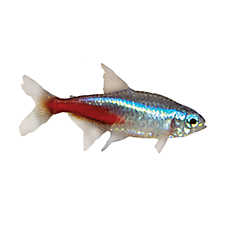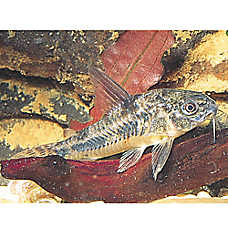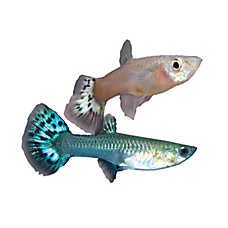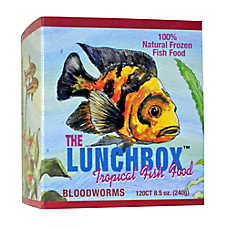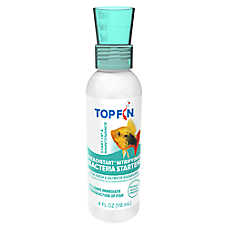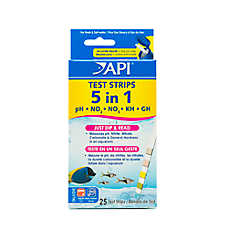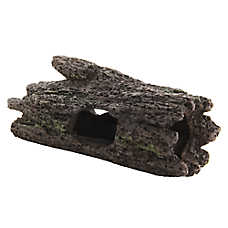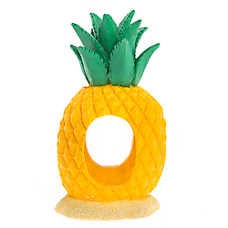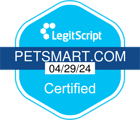Community Fish Care Guide
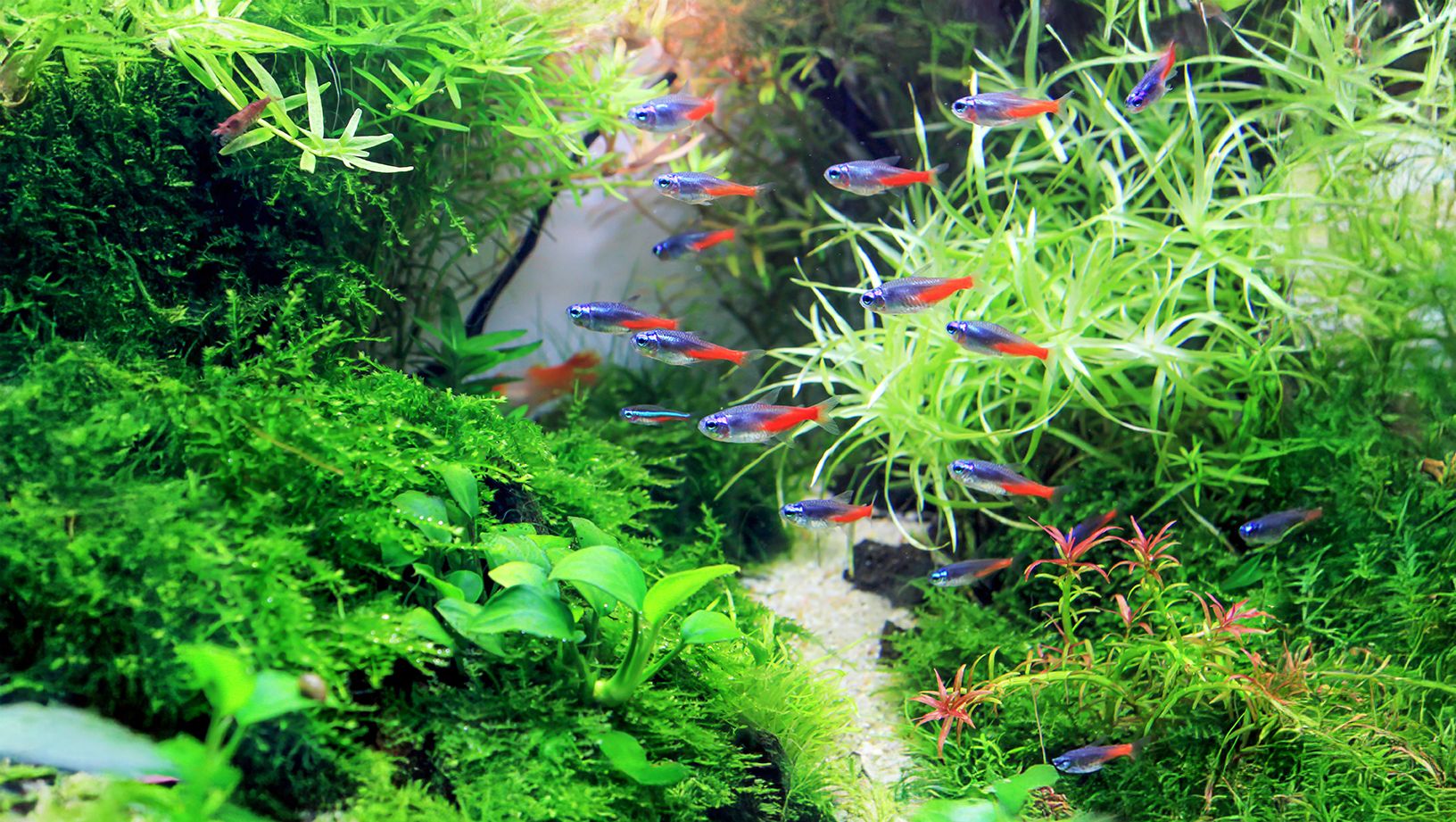
In this Article
Peaceful and Friendly
As the name suggests, these fish are usually peaceful and get along well together. Watching these fish as they go about their daily lives is fascinating and soothing. The term 'community fish' refers to a wide variety of peaceful species that prefer to live with other fish. These fish often coexist peacefully together, giving you a variety of fish in one place!
Behavior: When keeping fish as pets, there are no guarantees that the fish will get along. You should always monitor your fish for signs of stress or aggression and be prepared to move the fish from the aquarium.
Rearranging or adding décor can help create more territories and hiding spots, reducing stress in community tanks. Live plants support water quality and give fish safe places to rest. Often, the more plants and décor you add, the more active and visible your fish become! A tank with variety is more interesting for your fish - just like new toys or beds are for your dog or cat.
Rearranging or adding décor can help create more territories and hiding spots, reducing stress in community tanks. Live plants support water quality and give fish safe places to rest. Often, the more plants and décor you add, the more active and visible your fish become! A tank with variety is more interesting for your fish - just like new toys or beds are for your dog or cat.
If you’re planning a community tank, visit our Fish Compatibility Guide to find suitable tank mates.
Category Fish Types
Aquatic Amphibians
SIZE: Up to 2”
LIFESPAN: 5-8 years, potentially longer in ideal conditions
EXAMPLES: African Dwarf Frog (Hymenochirus curtipes)
TANK SIZE: 5+ gallons
WATER TEMP: 73-79° F (23-26° C)
HABITAT: Natural sand and décor. Lots of live plants are preferred. They need to surface to breathe so providing decorations they can rest on near the surface is important.
BEHAVIOR: Peaceful
SCHOOLING: Yes, best kept in groups of at least 2 or more of the same species.
COMMUNITY: They do well with peaceful fish too large to fit into their mouths. They may prey on shrimp or small fish.
NATURAL DIET: Insects and small crustaceans
FOOD: They do best fed frozen bloodworms or brine shrimp daily. High quality, small carnivore pellets can be offered.
LIFESPAN: 5-8 years, potentially longer in ideal conditions
EXAMPLES: African Dwarf Frog (Hymenochirus curtipes)
TANK SIZE: 5+ gallons
WATER TEMP: 73-79° F (23-26° C)
HABITAT: Natural sand and décor. Lots of live plants are preferred. They need to surface to breathe so providing decorations they can rest on near the surface is important.
BEHAVIOR: Peaceful
SCHOOLING: Yes, best kept in groups of at least 2 or more of the same species.
COMMUNITY: They do well with peaceful fish too large to fit into their mouths. They may prey on shrimp or small fish.
NATURAL DIET: Insects and small crustaceans
FOOD: They do best fed frozen bloodworms or brine shrimp daily. High quality, small carnivore pellets can be offered.
Danio, Rasbora and Tetra
SIZE: Up to 3"
LIFESPAN: 2-3 years, potentially longer in ideal conditions
EXAMPLES: Zebra Danio (Danio rerio), Scissortail Rasbora (Rasbora trilineata), Neon Tetra (Paracheirodon innesi)
TANK SIZE: 10+ gallon
WATER TEMP: 78-82° F (25-27° C)
HABITAT: Natural gravel and décor. Lots of live plants are preferred.
BEHAVIOR: Peaceful
SCHOOLING: Yes, best kept in groups of at least 5 or more of the same species.
COMMUNITY: This group looks stunning in a heavily planted tank and can cohabitate with other peaceful fish and often with some semi-aggressive fish.
NATURAL DIET: Small insects, crustaceans & algae.
FOOD: High-quality tropical fish flakes and frozen fish food occasionally
LIFESPAN: 2-3 years, potentially longer in ideal conditions
EXAMPLES: Zebra Danio (Danio rerio), Scissortail Rasbora (Rasbora trilineata), Neon Tetra (Paracheirodon innesi)
TANK SIZE: 10+ gallon
WATER TEMP: 78-82° F (25-27° C)
HABITAT: Natural gravel and décor. Lots of live plants are preferred.
BEHAVIOR: Peaceful
SCHOOLING: Yes, best kept in groups of at least 5 or more of the same species.
COMMUNITY: This group looks stunning in a heavily planted tank and can cohabitate with other peaceful fish and often with some semi-aggressive fish.
NATURAL DIET: Small insects, crustaceans & algae.
FOOD: High-quality tropical fish flakes and frozen fish food occasionally
Freshwater Shrimp
SIZE: Up to 3"
LIFESPAN: Rock Shrimp 1-2 years, others up to 1 year, potentially longer in ideal conditions
EXAMPLES: Rock Shrimp (Atyopsis moluccensis), Fancy Shrimp (Neocaridina/Caridina), Ghost Shrimp (Palaemonetes vulgaris)
TANK SIZE: 3+ gallon
WATER TEMP: 70-78° F (25-26° C)
HABITAT: Natural gravel or sand, décor, driftwood and heavily planted.
BEHAVIOR: Peaceful
SCHOOLING: While shrimp do not school like fish, they tend to live in large communities
COMMUNITY: Will do well in small to medium sized planted community tanks with small, peaceful fish. Avoid semi-aggressive and large community fish which may prey on shrimp in your aquarium.
NATURAL DIET: Algae, decaying plant material. Rock Shrimp are filter feeders thriving on algae, plankton, and zooplankton suspended in the water.
FOOD: Available algae, appropriately sized sinking vegetable-based pellets, and blanched vegetables (broccoli, cucumber, zucchini, and leafy greens). Rock Shrimp are filter feeders and need a finely ground vegetable-based food.
LIFESPAN: Rock Shrimp 1-2 years, others up to 1 year, potentially longer in ideal conditions
EXAMPLES: Rock Shrimp (Atyopsis moluccensis), Fancy Shrimp (Neocaridina/Caridina), Ghost Shrimp (Palaemonetes vulgaris)
TANK SIZE: 3+ gallon
WATER TEMP: 70-78° F (25-26° C)
HABITAT: Natural gravel or sand, décor, driftwood and heavily planted.
BEHAVIOR: Peaceful
SCHOOLING: While shrimp do not school like fish, they tend to live in large communities
COMMUNITY: Will do well in small to medium sized planted community tanks with small, peaceful fish. Avoid semi-aggressive and large community fish which may prey on shrimp in your aquarium.
NATURAL DIET: Algae, decaying plant material. Rock Shrimp are filter feeders thriving on algae, plankton, and zooplankton suspended in the water.
FOOD: Available algae, appropriately sized sinking vegetable-based pellets, and blanched vegetables (broccoli, cucumber, zucchini, and leafy greens). Rock Shrimp are filter feeders and need a finely ground vegetable-based food.
Guppy
SIZE: Up to 2.5"
LIFESPAN: 2-3 years, potentially longer in ideal conditions
EXAMPLES: Tuxedo Guppy (Poecilia reticulata), Fancy Guppy (Poecilia reticulata), Endler's Livebearer (Poecilia wingei)
TANK SIZE: 10+ gallon
WATER TEMP: 78-80° F (25-26° C)
HABITAT: Natural gravel and a few ornaments/rocks. Lots of live plants are preferred.
BEHAVIOR: Peaceful
SCHOOLING: Yes, but they will do well individually. Monitor males for aggression.
COMMUNITY: Guppies are tolerant of many other fish but avoid fish with a tendency to nip at other fish’s fins as Guppies have large, brightly colored fins. Mixing Male and Female Guppies will result in baby guppies in your tank.
NATURAL DIET: Small insects, crustaceans & algae.
FOOD: High-quality tropical fish flakes and frozen fish food occasionally
LIFESPAN: 2-3 years, potentially longer in ideal conditions
EXAMPLES: Tuxedo Guppy (Poecilia reticulata), Fancy Guppy (Poecilia reticulata), Endler's Livebearer (Poecilia wingei)
TANK SIZE: 10+ gallon
WATER TEMP: 78-80° F (25-26° C)
HABITAT: Natural gravel and a few ornaments/rocks. Lots of live plants are preferred.
BEHAVIOR: Peaceful
SCHOOLING: Yes, but they will do well individually. Monitor males for aggression.
COMMUNITY: Guppies are tolerant of many other fish but avoid fish with a tendency to nip at other fish’s fins as Guppies have large, brightly colored fins. Mixing Male and Female Guppies will result in baby guppies in your tank.
NATURAL DIET: Small insects, crustaceans & algae.
FOOD: High-quality tropical fish flakes and frozen fish food occasionally
Large Plecostomus
SIZE: Up to 24"
LIFESPAN: 10-15 years, potentially longer in ideal conditions
EXAMPLES: Plecostomus (Pterygoplichthys pardalis), High Fin Spotted Plecostomus (Glyptoperichthys gibbiceps)
TANK SIZE: 125+ gallon
WATER TEMP: 75-79° F (24-26° C)
HABITAT: Natural gravel, ornaments, driftwood and live or artificial plants.
BEHAVIOR: Peaceful
SCHOOLING: No, these large plecos are primarily solitary
COMMUNITY: Will do well with most other fish as long as the aquarium is large enough for them.
NATURAL DIET: Plants, algae, driftwood. Often opportunistic scavengers.
FOOD: Available algae, appropriately sized sinking vegetable-based pellets, and vegetables like zucchini. Many plecos need driftwood in the tank for proper digestion.
LIFESPAN: 10-15 years, potentially longer in ideal conditions
EXAMPLES: Plecostomus (Pterygoplichthys pardalis), High Fin Spotted Plecostomus (Glyptoperichthys gibbiceps)
TANK SIZE: 125+ gallon
WATER TEMP: 75-79° F (24-26° C)
HABITAT: Natural gravel, ornaments, driftwood and live or artificial plants.
BEHAVIOR: Peaceful
SCHOOLING: No, these large plecos are primarily solitary
COMMUNITY: Will do well with most other fish as long as the aquarium is large enough for them.
NATURAL DIET: Plants, algae, driftwood. Often opportunistic scavengers.
FOOD: Available algae, appropriately sized sinking vegetable-based pellets, and vegetables like zucchini. Many plecos need driftwood in the tank for proper digestion.
Molly, Platy & Swordtail
SIZE: Up to 4"
LIFESPAN: 3-5 years, potentially longer in ideal conditions
EXAMPLES: Black Molly (Poecilia latipinna), Red Wag Platy (Xiphophorus helleri), Velvet Wag Swordtail (Xiphophorus maculatus)
TANK SIZE: 10+ gallon
WATER TEMP: 78-80° F (25-26° C)
HABITAT: Natural gravel and a few ornaments/rocks, and live or artificial plants.
BEHAVIOR: Peaceful
SCHOOLING: Yes, but they will do well individually. Monitor groups for aggression.
COMMUNITY: Mollies, platies, and swordtails all have similar behavior, appearance, and water parameters. They tend to do well together and can coexist with most semi-aggressive fish and larger community fish.
NATURAL DIET: Small insects, crustaceans & algae.
FOOD: High-quality tropical fish flakes and frozen fish food occasionally
LIFESPAN: 3-5 years, potentially longer in ideal conditions
EXAMPLES: Black Molly (Poecilia latipinna), Red Wag Platy (Xiphophorus helleri), Velvet Wag Swordtail (Xiphophorus maculatus)
TANK SIZE: 10+ gallon
WATER TEMP: 78-80° F (25-26° C)
HABITAT: Natural gravel and a few ornaments/rocks, and live or artificial plants.
BEHAVIOR: Peaceful
SCHOOLING: Yes, but they will do well individually. Monitor groups for aggression.
COMMUNITY: Mollies, platies, and swordtails all have similar behavior, appearance, and water parameters. They tend to do well together and can coexist with most semi-aggressive fish and larger community fish.
NATURAL DIET: Small insects, crustaceans & algae.
FOOD: High-quality tropical fish flakes and frozen fish food occasionally
Semi-Aggressive Algae Eater
SIZE: Up to 11"
LIFESPAN: 8-10 years, potentially longer in ideal conditions
EXAMPLES: Chinese Algae Eater (Gyrinocheilus aymonieri)
TANK SIZE: 50+ gallon
WATER TEMP: 78-80° F (25-26° C)
HABITAT: Natural gravel and a few ornaments/rocks.
BEHAVIOR: Semi-Aggressive
SCHOOLING: These fish do well as an individual specimen in a semi-aggressive aquarium or with large community fish. They do not tolerate smaller, similar looking fish such as loaches, freshwater sharks, or other algae eaters. In a large enough aquarium, groups of 6 or more can show fascinating community behaviors.
COMMUNITY: Will do well in a large semi-aggressive aquarium or in a large community aquarium with similarly sized fish.
NATURAL DIET: Algae, small crustaceans, and insect larvae
FOOD: Available algae, appropriately sized sinking vegetable-based pellets, and blanched vegetables (broccoli, cucumber, zucchini, and leafy greens).
LIFESPAN: 8-10 years, potentially longer in ideal conditions
EXAMPLES: Chinese Algae Eater (Gyrinocheilus aymonieri)
TANK SIZE: 50+ gallon
WATER TEMP: 78-80° F (25-26° C)
HABITAT: Natural gravel and a few ornaments/rocks.
BEHAVIOR: Semi-Aggressive
SCHOOLING: These fish do well as an individual specimen in a semi-aggressive aquarium or with large community fish. They do not tolerate smaller, similar looking fish such as loaches, freshwater sharks, or other algae eaters. In a large enough aquarium, groups of 6 or more can show fascinating community behaviors.
COMMUNITY: Will do well in a large semi-aggressive aquarium or in a large community aquarium with similarly sized fish.
NATURAL DIET: Algae, small crustaceans, and insect larvae
FOOD: Available algae, appropriately sized sinking vegetable-based pellets, and blanched vegetables (broccoli, cucumber, zucchini, and leafy greens).
Small Algae Eater
SIZE: Up to 2"
LIFESPAN: 2-3 years for Otocinclus, Small Plecos 5-10 years potentially longer in ideal conditions
EXAMPLES: Otocinclus Catfish (Otocinclus vittatus), Bristlenose Plecostomus (Ancistrus cirrhosus), Rubber Lip Plecostomus (Chaetostoma formosae)
TANK SIZE: 10+ gallon (Otocinclus), 20+ gallons for all others
WATER TEMP: 78-82° F (25-27° C)
HABITAT: Natural gravel, décor, driftwood and heavily planted.
BEHAVIOR: Peaceful
SCHOOLING: Otocinclus do best in groups of 6 or more. Plecos, however, tend to be solitary or live in loose community groups. Males may not tolerate other males in the same aquarium.
COMMUNITY: Will do well in small to large heavily planted community aquariums with soft water and lower pH.
NATURAL DIET: Small insects, crustaceans & algae.
FOOD: Available algae, appropriately sized sinking vegetable-based pellets, and blanched vegetables (broccoli, cucumber, zucchini, and leafy greens). Many plecos need driftwood in the tank for proper digestion.
LIFESPAN: 2-3 years for Otocinclus, Small Plecos 5-10 years potentially longer in ideal conditions
EXAMPLES: Otocinclus Catfish (Otocinclus vittatus), Bristlenose Plecostomus (Ancistrus cirrhosus), Rubber Lip Plecostomus (Chaetostoma formosae)
TANK SIZE: 10+ gallon (Otocinclus), 20+ gallons for all others
WATER TEMP: 78-82° F (25-27° C)
HABITAT: Natural gravel, décor, driftwood and heavily planted.
BEHAVIOR: Peaceful
SCHOOLING: Otocinclus do best in groups of 6 or more. Plecos, however, tend to be solitary or live in loose community groups. Males may not tolerate other males in the same aquarium.
COMMUNITY: Will do well in small to large heavily planted community aquariums with soft water and lower pH.
NATURAL DIET: Small insects, crustaceans & algae.
FOOD: Available algae, appropriately sized sinking vegetable-based pellets, and blanched vegetables (broccoli, cucumber, zucchini, and leafy greens). Many plecos need driftwood in the tank for proper digestion.
Small Schooling Catfish
SIZE: Up to 3"
LIFESPAN: 3-5 years, potentially longer in ideal conditions
EXAMPLES: Julii Cory Catfish (Corydoras julii), Panda Cory Catfish (Corydoras panda), Glo Cory Catfish (Corydoras aeneus)
TANK SIZE: 20+ gallon
WATER TEMP: 78-82° F (25-27° C)
HABITAT: Natural sand substrate and décor. Lots of live plants are preferred.
BEHAVIOR: Peaceful
SCHOOLING: Yes, best kept in groups of at least 5 or more of the same species.
COMMUNITY: Will do well in planted community tanks with other peaceful fish. Various types of corydoras will often school together.
NATURAL DIET: Omnivorous scavenger
FOOD: High-quality sinking pellets and frozen fish food occasionally
LIFESPAN: 3-5 years, potentially longer in ideal conditions
EXAMPLES: Julii Cory Catfish (Corydoras julii), Panda Cory Catfish (Corydoras panda), Glo Cory Catfish (Corydoras aeneus)
TANK SIZE: 20+ gallon
WATER TEMP: 78-82° F (25-27° C)
HABITAT: Natural sand substrate and décor. Lots of live plants are preferred.
BEHAVIOR: Peaceful
SCHOOLING: Yes, best kept in groups of at least 5 or more of the same species.
COMMUNITY: Will do well in planted community tanks with other peaceful fish. Various types of corydoras will often school together.
NATURAL DIET: Omnivorous scavenger
FOOD: High-quality sinking pellets and frozen fish food occasionally
Snail
SIZE: Up to 3"
LIFESPAN: 1-3 years, potentially longer in ideal conditions
EXAMPLES: Mystery Snail (Pomacea bridgesii), Nerite Snail (Neritina turrita)
TANK SIZE: 10+ gallon
WATER TEMP: 70-78° F (25-27° C)
HABITAT: Natural gravel, décor, driftwood and live or artificial plants.
BEHAVIOR: Peaceful
SCHOOLING: While often found in communal groups, snails do well as individual specimens in an aquarium. Mystery Snails may reproduce if kept in groups.
COMMUNITY: Will do well in small to medium sized community tanks with peaceful fish. Avoid barbs, loaches, goldfish, and koi as these categories may enjoy consuming snails.
FOOD: Available algae, appropriately sized sinking vegetable-based pellets, and blanched vegetables (broccoli, cucumber, zucchini, and leafy greens).
LIFESPAN: 1-3 years, potentially longer in ideal conditions
EXAMPLES: Mystery Snail (Pomacea bridgesii), Nerite Snail (Neritina turrita)
TANK SIZE: 10+ gallon
WATER TEMP: 70-78° F (25-27° C)
HABITAT: Natural gravel, décor, driftwood and live or artificial plants.
BEHAVIOR: Peaceful
SCHOOLING: While often found in communal groups, snails do well as individual specimens in an aquarium. Mystery Snails may reproduce if kept in groups.
COMMUNITY: Will do well in small to medium sized community tanks with peaceful fish. Avoid barbs, loaches, goldfish, and koi as these categories may enjoy consuming snails.
FOOD: Available algae, appropriately sized sinking vegetable-based pellets, and blanched vegetables (broccoli, cucumber, zucchini, and leafy greens).
How Do I Set Up a Community Fish Aquarium?
Typical Community Fish Aquarium Includes:
- Glass or acrylic tank
- Hood or tank cover with light
- Thermometer
- Substrate: Gravel or sand
- Décor for hiding and enrichment
- Live or artificial plants
- Heater
- Filter
Setup Steps:
- Choose your equipment: Select an appropriately sized tank, substrate, décor, heater, and filter. A PetSmart associate can help guide your selections.
- Prepare your space: Place the aquarium on a flat, stable surface that can support its full weight - water weighs 8.3 pounds per gallon.
- Rinse and place décor: Rinse all substrate and decorations with tap water (never soap), then add to the tank.
- Add water and conditioner: Fill with tap water and use a water conditioner to remove chlorine and chloramines. If your home uses a water softener, use a tap source that bypasses it.
- Install and test equipment: Set up the heater, filter, and thermometer per manufacturer instructions. Add the hood and lighting and set lights on a 12-hour cycle using a timer for consistency.
- Let the tank stabilize: Run the system for at least 24 hours to ensure all equipment works and the water temperature is stable.
- Begin cycling the tank: Add a beneficial bacteria starter and introduce just a few hardy fish to start, or follow a fishless cycling process to reduce stress.
- Monitor water quality daily: During cycling, test water regularly. Perform a water change if ammonia or nitrite is above 0 ppm or if nitrate exceeds 20 ppm. Always add water conditioner after each change.
- Add fish gradually: Once your tank is cycled and stable, add compatible fish slowly and monitor for any signs of illness or stress.
- Before adding new species, review our Fish Compatibility Guide for compatibility tips.
- Quarantine new additions: To protect your established aquarium, quarantine new fish for 30 days in a separate, cycled setup.
Learn more about fish-less cycling in Setting Up an Aquarium.
When should I test my water quality?
- Fish are sluggish, near the bottom of the tank
- Fish are at the top, breaking the water to breathe
- Fish are not eating
- Sudden behavior changes in your fish
- Water is cloudy
- Water smells funny
PetSmart offers free water quality testing and one of our knowledgeable associates can help you get your system balanced.
When should I contact a veterinarian?
Contact an aquatic veterinarian if you notice the following signs:
- Unusual swimming pattern
- Thinness or decreased appetite
- Abdominal swelling
- Inflamed or discolored skin/fins
- Fins clamped to sides of body
- Scraping body on rocks (flashing)
- Visible signs of illness or recent fish loss
If your fish show any of the signs above, we recommend using the “Find a Fish Vet” tool at fishvets.org or wavma.org to locate a qualified aquatic veterinarian in your area.
Shopping Checklist
What will I need for my community fish?
- Aquarium sized appropriately for the species and number of fish, (10-20+ gallon) with stand
- Aquarium top/hood with light fixture
- Natural aquarium gravel or sand & gravel vacuum
- Tank décor like driftwood or ornaments
- Live or artificial plants
- Aquarium heater and thermometer
- Aquarium filter sized for your tank
- Water testing kit or strips
- Water conditioner/dechlorinator
- Beneficial bacteria starter
- Algae cleaning pad or scraper
- Species-appropriate pellets or flakes and frozen fish food
Ready to learn more?
This guide is a great starting place, but we encourage you to do more research on the individual species that you are keeping so that you can be as successful as possible with your aquarium!
Related guides:
Vet Assured™: Pets purchased at PetSmart are part of our exclusive Vet Assured™ program, designed by PetSmart veterinarians to help improve the health and well-being of our pets. Our vendors meet a high
standard in caring for pets and screening them for common illnesses. This program also includes specific standards for in-store pet care.
The PetSmart Promise: If your pet becomes ill during the initial 14-day period, or if you’re not satisfied for any reason, PetSmart will gladly replace the pet or refund the purchase price.
Safety tips for you and your pet: 1. ALL ANIMALS can potentially carry viral, bacterial, fungal, and parasitic diseases contagious to humans. 2. Thoroughly wash your hands with warm, soapy water before and after contact with any pet or its habitat. 3. Adults should assist children with hand washing after contact with a pet, its habitat or aquarium water. 4. Always add a dechlorinator or water conditioner and bacteria starter to tap water before adding it to the aquarium. 5. Do not use soaps or detergents to clean aquarium or decor, since they are toxic to fish. For more information, visit petsmart.com, cdc.gov/healthypets, or contact your veterinarian.
This care guide contains general information for the proper care of your pet, but is not comprehensive and is not a substitute for veterinary advice or care.
PETSMART and VET ASSURED are trademarks of PetSmart Home Office, Inc. © 2025 PetSmart. All rights reserved.
standard in caring for pets and screening them for common illnesses. This program also includes specific standards for in-store pet care.
The PetSmart Promise: If your pet becomes ill during the initial 14-day period, or if you’re not satisfied for any reason, PetSmart will gladly replace the pet or refund the purchase price.
Safety tips for you and your pet: 1. ALL ANIMALS can potentially carry viral, bacterial, fungal, and parasitic diseases contagious to humans. 2. Thoroughly wash your hands with warm, soapy water before and after contact with any pet or its habitat. 3. Adults should assist children with hand washing after contact with a pet, its habitat or aquarium water. 4. Always add a dechlorinator or water conditioner and bacteria starter to tap water before adding it to the aquarium. 5. Do not use soaps or detergents to clean aquarium or decor, since they are toxic to fish. For more information, visit petsmart.com, cdc.gov/healthypets, or contact your veterinarian.
This care guide contains general information for the proper care of your pet, but is not comprehensive and is not a substitute for veterinary advice or care.
PETSMART and VET ASSURED are trademarks of PetSmart Home Office, Inc. © 2025 PetSmart. All rights reserved.
